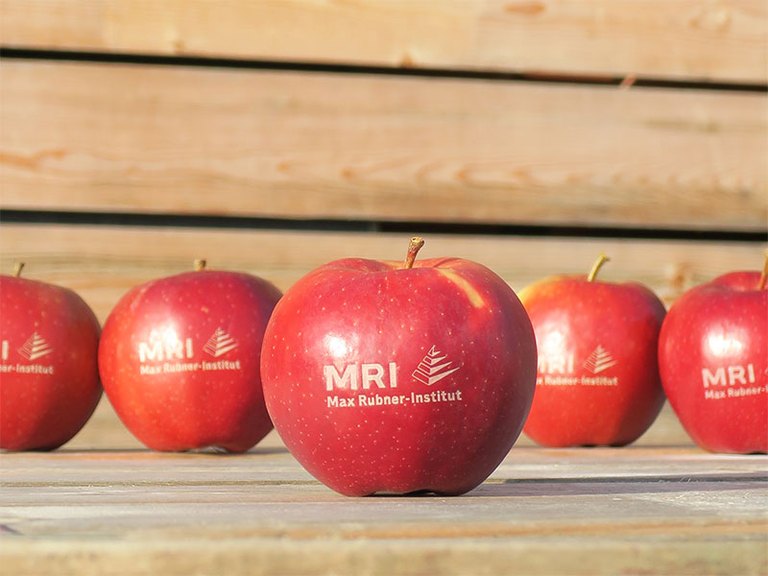Where does the tomato come from? Is the cucumber organic or not? Was the banana really fair trade - or does it just happen to be among the FairTrade fruits? Questions like these are increasingly being asked by consumers when buying groceries. In order to meet this need for information, food today has to be well labelled. Because in addition to the visual impression, the taste or the health value, other product properties are often decisive for a purchase today. Important information relates to the place of production, the variety or the cultivation method. However, conventional information carriers such as packaging, bands or adhesive labels have certain disadvantages: they have to be recycled or disposed of, and bands and adhesive labels can also be lost. For this reason, alternatives are being discussed to permanently attach important product information to the food itself.
Laser labelling is the answer
Similar to applications in medical technology, laser beams can also be used on food to change surface structures or to remove material to a limited extent. In other words, laser technology makes it possible to colour or structure the surface of fruit, creating permanently visible lettering, symbols and even barcodes. In this way, important information can be attached directly to the food - without plastic waste and so that it cannot be lost. For laser labelling, which is also referred to as "natural branding", carbon dioxide low-energy lasers are currently typically used in commercial practice for the labeling of food, because the laser energy used can be dosed very well here. However, there are also other types of lasers that are in principle also suitable for this purpose. The concept has already convinced some food retailers and marketers: Laser-marked fruit and vegetables are already available in retail outlets in some places.
One solution for all fruits?
The advantages are offset by two possible disadvantages: on the one hand, damage to the outer skin layer can affect the shelf life of the fruit, and on the other hand, lasering can affect the composition of the fruit skin. However, whether this is really relevant depends on the type of fruit. Typically, laser labelling has so far been used on fruits with a thick or firm skin, such as citrus fruits, avocados, mangoes, sweet potatoes, ginger or bananas. Laser labelling is particularly suited on these fruits because the superficial changes in the skin area have little effect on the shelf life of the product. Since the peels of these fruits are not eaten, the question of health safety does not arise in this case.
In the case of fruits with soft or thin skins, like apples and tomatoes, exactly dosing the laser labelling is technically much more challenging and the fruit may be more susceptible to loss of water and spoilage after laser treatment. Especially with thin-skinned fruit, it is therefore important to achieve a good compromise between a sufficient visibility of the laser marking and the least possible impairment of the barrier function of the peel. Moreover, data is required as a basis for recommending whether the parts of the skin that have been laser treated can be eaten or should rather be removed as a precaution.
Laser labeling on apples
While there have already been some scientific studies on the general effects of laser treatment on the fruit peel and the shelf life of laser-labelled fruit, the effects of laser beams on the components of the fruit peel have been little researched. In a current research project, the Max Rubner-Institut in Karlsruhe and the University of Applied Sciences Osnabrück are therefore jointly investigating what changes occur in the skin as a result of laser treatment, using apples as an example.
In a first step, Braeburn apples were treated with a carbon dioxide laser and different levels of laser energy. Subsequently, peel samples were characterized by light microscopy, scanning electron microscopy, sensory and an untargeted metabolite profiling analysis. First, it was confirmed that laser labelling inevitably affects the integrity of the peel barrier. At low energy levels, the natural wax layer is more or less removed; at higher energies, the underlying cell layers are also destroyed. The stronger the laser marking, the more pronounced the water loss and subsequent tissue shrinkage. However, if labelled fruit is stored at low temperatures (e.g. 1 °C), the fruit quality can be preserved for longer. The visibility of the laser marking increases with the laser energy applied, but also depends on the colour (red or yellowish-green) of the respective peel area. According to the chemical analyses, the laser treatment caused a significant stress response in the affected plant tissue and the ablated wax layer was not restored during the post-treatment storage. Undesirable or hazardous compounds have not yet been detected in the peel samples so far.
As a next step, the effects of marking peel tissue using other types of lasers are to be investigated.


